Table of contents
- 6 motorcycles in the consumption test Test series across all classes
- So was tested
- Honda CB 300 R.
- KTM 790 Duke
- Yamaha MT-09
- Kawasaki Ninja H2 SX
- Ducati Panigale V4 S.
- Honda GL 1800 Gold Wing
- Fuel saving tips
- Practice-related test scenario
- Consumption after 120 km of country road
- Determination of minimum consumption
- Determination of maximum consumption
- Gasoline price development since the 1970s

Tyson Jopson
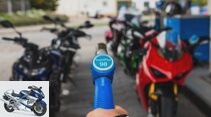
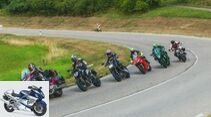
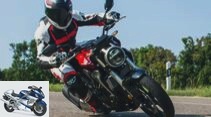

13th pictures
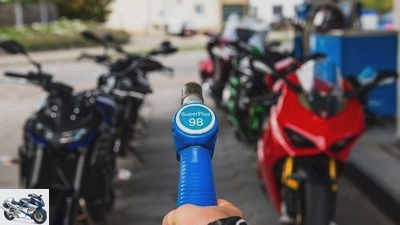
Tyson Jopson
1/13
What is the current state of affairs in terms of fuel consumption? A series of experiments.
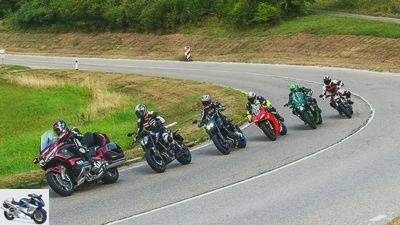
Tyson Jopson
2/13
We let the engines pull through with relish in their optimal torque range, and if possible, we make the most of the acceleration.
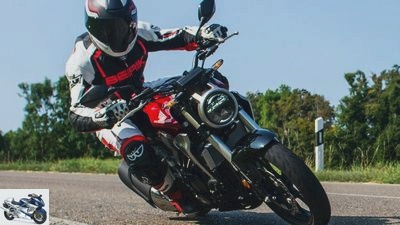
Tyson Jopson
3/13
Honda CB 300 R..

Tyson Jopson
4/13
KTM 790 Duke.
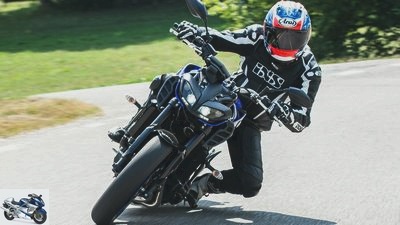
Tyson Jopson
5/13
Yamaha MT-09.

Tyson Jopson
6/13
Kawasaki Ninja H2 SX.
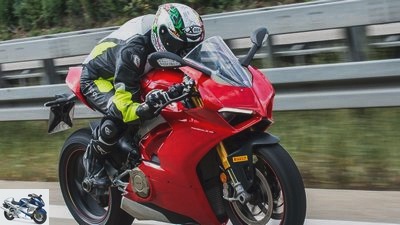
Tyson Jopson
7/13
Ducati Panigale V4 S..
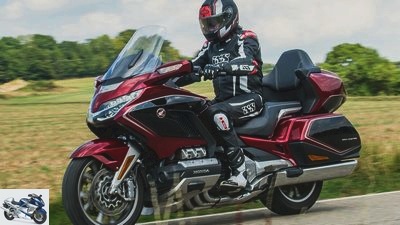
Tyson Jopson
8/13
Honda GL 1800 Gold Wing.
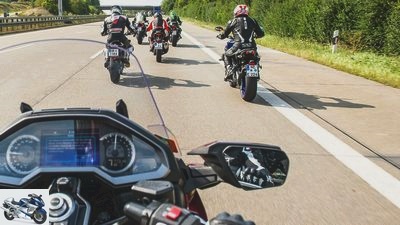
Tyson Jopson
9/13
What follows now is only recommended for masochists to imitate: the attempt to come as close as possible to the theoretically achievable minimum consumption in practice.
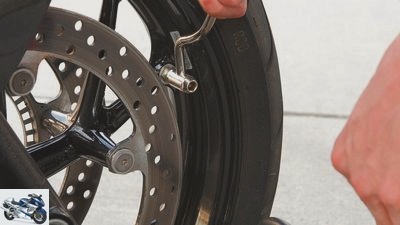
Tyson Jopson
10/13
On long stretches of the motorway, the air pressure should be increased to the maximum permitted level.
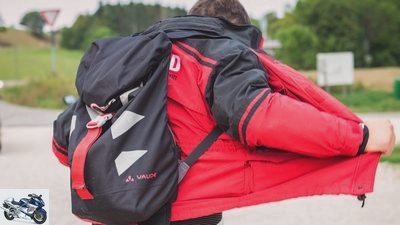
Tyson Jopson
11/13
A jacket that inflates in the airstream slows you down considerably and increases fuel consumption. Same with an empty rucksack.

Tyson Jopson
12/13
The drive chain must be checked for tension and adequate lubrication.

Tyson Jopson
13/13
Do you really need the suitcase and topcase for the tour on Sunday? If not: lose weight!
motorcycles
Gasoline consumption of motorcycles
6 motorcycles in the consumption test
Test series across all classes
What is the current state of affairs in terms of fuel consumption in motorcycles? A test series with Honda CB 300 R, KTM 790 Duke, Yamaha MT-09, Kawasaki Ninja H2 SX, Ducati Panigale V4 S and Honda GL 1800 Gold Wing.
Johannes Muller
01/14/2019
At this point, it is not about the competition of drive concepts, but about the efficiency of internal combustion engines. After all, fossil fuel is finite and there is no free fire water either. So what is the state of affairs in terms of consumption? To answer this, we have assembled six machines of the latest generation for an extensive consumption test. One, two, three, four and six cylinders, forced ventilation once, 30 to 214 hp. A broad spectrum. How much do Honda CB 300 R, KTM 790 Duke, Yamaha MT-09 consume, Kawasaki Ninja H2 SX, Ducati Panigale V4 S and Honda Gold wing minimal, how much maximal? And how much with a brisk country road rush?
Buy complete article
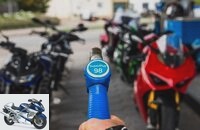
6 motorcycles in the consumption test
Test series across all classes
8 pages) as PDF
€ 2.00
Buy now
So was tested
Minimum consumption: Was determined on the highway. Immediately shift into top gear and roll along at moderate speed with a consistently low load.
Maximum consumption: Was determined on a non-speed limited motorway. The full load share should be as large as possible.
Country road afloat: Brisk pace, it could be accelerated vigorously. The speeds moved in the optimal torque range. Alternating acceleration and braking phases.
Honda CB 300 R.
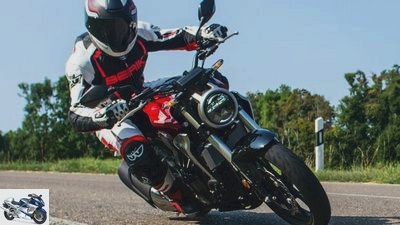
Tyson Jopson
2.2 liters minimum consumption, 7.2 liters maximum consumption and 3.3 liters on the country road – that was the result of the consumption test for the Honda CB 300 R..
Light, single-cylinder, modern – and therefore predestined for very low consumption. Which can also be easily implemented. Even a moderately cautious hand on the throttle is rewarded with the two to the decimal point, and consumption remains very low even on brisk lap. Only Autobahn-Gebolze costs.
KTM 790 Duke

Tyson Jopson
3.2 liters minimum consumption, 8.5 liters maximum consumption and 4.5 liters on the country road – this is the balance sheet for the KTM 790 Duke.
the 790 Duke knows how to convince all along the line when it comes to consumption. Comfortable country road speed is rewarded with four point nothing, really fun is with significantly less than five liters. Finally, and this is a sensation, full throttle consumption almost on par with a 30 hp single cylinder.
Yamaha MT-09
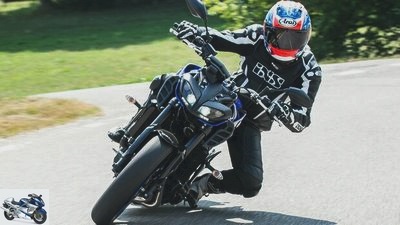
Tyson Jopson
3.3 liters minimum consumption, 10.4 liters maximum consumption and 4.8 liters on the country road – it is with the Yamaha MT-09.
The MT-09 also noticeably rewards driving with brains. Less than five liters are easily compatible with having fun, less is always possible. But blunt blasts drive consumption up significantly – we chased over ten liters through the nozzles on the motorway. And that despite the limiter at 210.
Kawasaki Ninja H2 SX
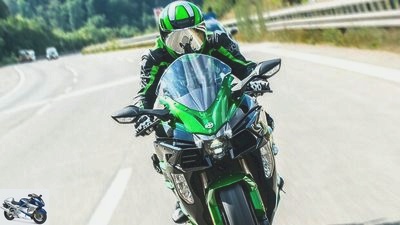
Tyson Jopson
3.9 liters of minimum consumption, 13.5 liters of maximum consumption and 5.2 liters on the country road – that was the result of the consumption test for the Kawasaki Ninja H2 SX.
What a spectrum: Less than four liters are possible, or easily over 13 – whereby the latter value can probably be raised by one or the other liter if the path is completely free. Normally, however, the Kawasaki highly disciplined in handling fuel despite the compressor. That deserves recognition.
Ducati Panigale V4 S.
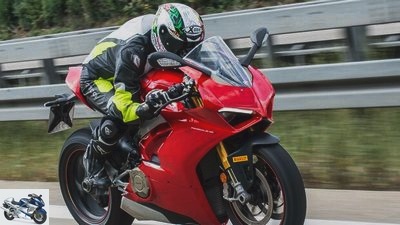
Tyson Jopson
4.7 liters of minimum consumption, 13.8 liters of maximum consumption and 8.1 liters on the country road – that’s it for the Ducati Panigale V4 S..
Is 13.8 liters a lot? Certainly at first glance. But firstly, in the last consumption comparison in 2013, it was still possible to blow 15.9 liters on a 1299 Panigale – and secondly, the maximum consumption appears relatively humane in view of the driving performance offered. Rather, the high normal consumption can be taken aback.
Honda GL 1800 Gold Wing
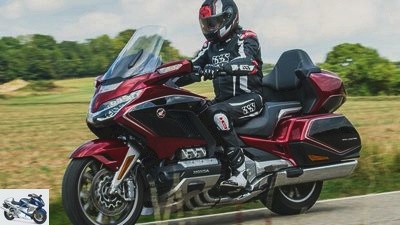
Tyson Jopson
3.8 liters minimum consumption, 10.3 liters maximum consumption and 5.6 liters on the country road – this is the balance sheet for the Honda GL 1800 Gold Wing.
Despite its weight and six-cylinder design, the GL 1800 is satisfied with commendably little fuel. After all, it weighs as much as two and a half CB 300, has six times as much displacement and cylinders – but does not consume twice as much. Progress: Earlier Gold Wings were nowhere near as economical.
Fuel saving tips
If you observe the following measures and tips, you can reduce your individual fuel consumption – without any loss of driving dynamics.
Check air pressure: Checking the air pressure at regular intervals and correcting it according to the manufacturer’s recommendation is a sensible thing anyway. On longer stretches of the motorway, it is advisable to increase the air pressure to the maximum permissible level.
Check drive chain: A worn or incorrectly tensioned chain costs just as much power and therefore gasoline as insufficient lubrication.
Unnecessary ballast: Side cases, top cases and rucksacks are fine transport media. If they are not needed, however, the motto is: put them down! Due to the poor aerodynamics and the additional weight, the fuel requirement increases unnecessarily.
Clothing: It is not only for safety reasons that you should pay attention to flutter-free and tight-fitting protective clothing. Jackets that are too big inflate and cost fuel, especially at high speeds.
Cold start: If the engine is still cold, it uses significantly more fuel than when it is at operating temperature. Therefore, it is best to drive off gently and at low speeds immediately after starting the engine.
Round driving style: If you accelerate and brake a lot, you blow a lot of fuel. You move the motorcycle efficiently in the range of the maximum torque. If you choose your line cleanly and with foresight, you will hardly lose any dynamism and save fuel.
Avoid high speeds: The air resistance increases to the square of the speed. Double the pace? Quadruple air resistance! This also increases the required performance considerably. So you can save a lot with a little less speed on the train.
Practice-related test scenario
The usual MOTORRAD test consumption is not determined slowly, but moderately, with an emphatically anticipatory driving style. A little more fun can be had in the consumption test: We let the engines pull through with relish in their optimal torque range, and if possible, make the most of the acceleration. According to the fundamentally different engine and vehicle concepts, this leads to fundamentally different impressions. Example 790 Duke: The light Austro-Twin, the youngest engine in this field, was designed precisely for this purpose, it shakes the performance required for the brisk ride out of its sleeve in a particularly casual way. Moderate speeds, half throttle or three quarters at the most, that’s all you need for tingling driving pleasure. That bodes well for the billing. The same in the case of the MT-09, which is nominally a bit more powerful, but with an additional cylinder and piston plus valves – and with more friction at the same speed, this will result in increased consumption? In order not to lose the two mid-range Nakeds before the first corner, the 286-cubic single-cylinder has to be the preppy one CB 300 R on the other hand, ran pretty hard. He sees half throttle and medium speeds in a brisk column at most downhill, otherwise the short-translated dohc single cheers mostly in the upper third of the speed and with the shower wide open. This is also fun, but should increase the expected low basic consumption of the single cylinder a bit. How far?
In stark contrast to this, Kawasaki’s H2 SX, whose supercharged in-line four-cylinder is only marginally more than idle even for brisk country road speeds. Interesting: Does the compressor increase efficiency with this driving profile (less speed for the same power), or does it reduce it (losses via the mechanical drive of the loader)? Then Ducati’s Panigale V4 S: Your excess of sheer power is even greater. In contrast to the silky-soft, highly elastic Kawa engine, the Bologna-L4 rumbles due to its unconventional, two-cylinder imitating “twin pulse” ignition sequence through low speeds – to translate every degree of throttle grip into an angry shot forward just a few hundred revolutions afterwards. Half throttle or even three quarters at medium speeds? The driver’s license is already hanging by a thread. Even brisk country road speeds are still too tired for this motorcycle. Whether the restriction to throttle movements in the nano range and the – compared to the 1299 Panigale – then still feasible, lower speed level as well as the smaller combustion chambers, which are easier to handle with regard to optimal combustion, make the V4 an unexpected savings miracle?
The GL 1800 was a special case: its engine, which had six cylinders in a boxer configuration and was 1,833 cubic meters in size, had high torque reserves, but had to weigh 385 kilograms of ready-to-drive mass. That’s two and a half CB 300 R! In addition, the rather complex dual clutch transmission is likely to have more power compared to a sequential transmission. And with it efficiency.
Consumption after 120 km of country road
After a good 120 highly entertaining kilometers of country roads, the machines roll to the gas pump – the moment of truth. When scaled down to 100, the CB 300 R consumed 3.3 liters. A good value, but not a sensation. Relatively high loads and speeds prevent an even better result from the inherently safe, very efficient, single cylinder with a tame design. Measured against what is offered, the 4.8 liters of the three-cylinder MT are more interesting, even more so the just 4.5 liters of the 790 Duke Twin – in good mood mode, should be emphasized again. So far, a very positive result that clearly documents one thing: With the state of the art, great driving pleasure and low consumption can easily be reconciled.
The explanation of why the Duke is even more economical than the MT-09 has already been touched on: One less cylinder means fewer overall losses due to waste heat due to internal friction. In addition, the double ignition certainly helps the 790 Duke to ignite the mixture in an optimally controlled manner in all speed and load ranges.
Measured against what is offered, the H2 SX also consumes a stingy 5.2 liters. Helpful: The turbocharged four-cylinder in-line can withstand low speeds without complaint, and even then accelerates more than sufficiently powerful. Forced ventilation obviously does not have a negative effect in the current H2 SX in normal operation. What that would prove.
The Panigale’s balance sheet is a little less green. Sure, nobody had high expectations with regard to a flawless ecological balance of the V4 S. But the good eight liters, which gurgles into their nicely shaped tank after the trip, make you sit up and take notice. Here one can also assume informed: Even as a V4, the Ducati Superbike is simply designed with other priorities in mind, profane economy off the racetrack can only have appeared in the specification sheet under further runs. The situation: An extremely short piston stroke is good for speed stability and top performance, but the relatively large bore that results from it then results in a combustion chamber shape that is unfavorable in terms of efficiency – more loss of thermal energy, poorer efficiency. Then extreme timing with long valve overlaps, large valves, short intake paths – all good for a lot of power. But all bad to convert the energy bound in the fuel into propulsion outside of the actual power range. Perhaps the decisive keyword: mixture enrichment. Whether when applying the gas to improve drivability, or for internal cooling – the Duc obviously indulges in plenty of it. The V4 unit could also be viewed as a heating and power plant in both senses of the word. Or more simply: effectiveness yes, efficiency no.
Surprise when the Honda follows up. 5.6 liters per 100 kilometers ridden quickly to demanding are more than remarkable. Enormous weight, enormous frontal area (air resistance!), But obviously great attention was paid to optimizing consumption with the Gold Wing. For example, there is the Unicam design borrowed from motocrossers, in which only one camshaft per cylinder bank controls the gas exchange, which saves parts and thus friction. And even if you explain it that way, the frugality of the six-cylinder is impressive. So all in all a very satisfactory result, as you can see from the Ducati away.
Determination of minimum consumption
What follows is only recommended for masochists to imitate: the attempt to come as close as possible to the theoretically achievable minimum consumption in practice. If you don’t have a closed-off route at the moment, this seems most likely to be possible on the autobahn: one and a half hours of constant travel at relatively low speed, in top gear with little speed, in a slippery position. No load changes, no energy wasting on brakes, rolling downhill. Maximum penalty? Without a doubt, but it was done in the service of science.
With 3.2 liters, the 790 Duke underlines its excellent efficiency again, closely followed by the MT-09 with 3.3 liters, which can be driven at even less speed than the Duke under these extreme conditions and therefore catches up. The Gold Wing is also rationing its supply: 3.8 liters. With her, the long-translated seventh gear of the DCT has a positive effect, which allows the engine to whisper away the kilometers at 90 km / h with barely four-digit speed. On top of that, the GL driver enjoys the luxury of being able to enjoy the on-board entertainment during this ordeal. It is also astonishing that the more than 200 hp Kawasaki could be moved with 3.9 liters per 100 kilometers, if you wanted to. The 4.7 liters of the Panigale are not a glory, they practically represent the minimum consumption achievable in the real world. In the last gear, the engine runs really smoothly in a column of trucks.
Finally the CB 300 R: 2.2 liters per 100 kilometers. That sounds great, and it is. But it would certainly be more economical. First of all, the single cylinder is of course predestined for crawl speed, as it does not drive any large power reserves unnecessary for this exercise. In addition, the compact machine offers the airflow one of the smallest areas of attack. But: In order not to become a dangerous permanent obstacle for trucks, you need a little over 80 kilometers per hour. For them, however, the engine has to rev up faster than the committed fuel saver would like. A constant speed of 60 to 65 kilometers per hour would be better. Then the engine moved in regions that were even more economical. Then, assuming a disciplined driver, there would be a one to the decimal point. Just imagine what a CB 300 R with a longer gear ratio, well-lubricated, narrow racing chain, smooth-running wheel bearings and slightly higher tire pressure would be capable of.
Determination of maximum consumption
We now stretch out the curved limbs, take a deep breath and take off for the last measurement run: maximum consumption. The end of all speed bans follows. 50 kilometers of motorway in one direction, 50 back. Full soup, whatever is possible, in the service of gaining knowledge. A simple matter with the CB 300 R: At Tacho 160 the stew is on, and that practically over 100 kilometers. Then makes 7.2 liters – 3.2 times the minimum consumption. The Gold Wing also completed the procedure with a reasonably manageable stress factor; it is electronically limited to 180 kilometers per hour, then injects 10.3 liters over the distance. The noticeably higher air resistance seems to take its toll here, because the MT-09, which is braked to 210 kilometers per hour, runs significantly faster, but consumes only slightly more at 10.4 liters at top speed. And again the 790 Duke makes a mark. Because it not only runs away openly at an impressive 250 kilometers per hour on the MT speedometer, but also consumes just 8.5 liters – the most outstanding value of the entire series of measurements.
And from then on it gets hearty. The Kawasaki scratches the 300 mark for this test without a case, so concentration is advised. Not that you could drive it long: At 13.5 liters per 100 kilometers, the radius of action shrinks to a manageable 141 kilometers. It is even worse in the seat of the Panigale V4 S. Here, and only here, the Duc can develop its motor potential in public traffic. And what kind of potential that is: We last measured it at a real 314 kilometers per hour – a slippery driver’s posture has long since ceased to be a savings strategy, but a necessity. Of course, this could not be achieved permanently – in that case the consumption would be slightly higher than the determined 13.8 liters. An inefficient engine? Only at a glance. If you put this consumption in relation to the work done, to the driving performance, the 13.8 liters seem to be economical. While other engines work efficiently in everyday life, the Panigale’s engine works efficiently in the high-performance range. And effective anyway.
Gasoline price development since the 1970s
We haven’t talked about gasoline prices in a long time? No wonder. After the all-time high in 2012, when the price for a liter of Super was 1.64 euros and thus a pain threshold for many, the situation has eased noticeably for a long time. The reasons for this are highly complex and, with the same high level of taxation, are related to global oil production, economic growth and energy demand, alternative production methods (keyword: oil sands), but also price speculation. One thing is clear: prices have been rising again since 2016, and in the medium term, given the finite nature of fossil fuels, despite the increasing importance of bio and synthetic fuels, development can only be expected in one direction – upwards. Therefore, even if motorcycling is mostly a hobby, it is worth doing a little math. An annual mileage of 3,000 kilometers costs EUR 168 with an average consumption of four liters, and EUR 252 with six liters. Everyone has to decide for themselves whether the difference of 84 euros matters. With three times the mileage, the additional costs are exactly 250 euros – after all, a set of tires.
Related articles
-
Comparison test gasoline consumption
Bilski 41 pictures Bilski 1/41 If you only take your motorcycle out of the garage on Sundays, you don’t care about the fuel consumption of your…
-
Practical test: gasoline consumption
counselor workshop Practical test: gasoline consumption Practical test: gasoline consumption Consumption advice Work makes you thirsty. That applies to…
-
Editors’ favorites Used motorcycles
KTM 22nd pictures archive 1/22 Honda VT 500 C: Rest? Relatively far back. Handlebar? Owing to the style of the time. But this engine: still nice to look…
-
Second-hand advice: Misunderstood motorcycles
fact counselor Used purchase Second-hand advice: Misunderstood motorcycles Second-hand advice: Misunderstood motorcycles Used bikes that nobody wants She…
-
Tops and Flops – Used Motorcycles 2016
markus-jahn.com, r-photography.info, jkuenstle.de, MOTORRAD-Archiv, Herzog, bilski-fotografie.de, fact.de 19th pictures jkuenstle.de 1/19 Second-hand…
-
Weird types of used advice – bizarre motorcycles from Japan
jkuenstle.de, Hartmann, Stefan Wolf, markus-jahn.com 9 pictures Rossen Gargolov 1/9 Klaus Herder (54), editor guidebook: Kawasaki VN 1500 Drifter (from…
-
Second-hand advice on turbo motorcycles
counselor Used purchase Second-hand advice on turbo motorcycles Second-hand advice on turbo motorcycles Company hot air The heated start to…
-
Used motorcycles between 1000 and 4000 euros
archive counselor Used purchase Used motorcycles between 1000 and 4000 euros Advice on used bikes from 1000 to 4000 euros Bargain motorcycles It wasn’t…
-
Touring motorcycles in a used check
archive counselor Used purchase Touring motorcycles in a used check Touring motorcycles in a used check Travel machines up to 2500 euros Anyone who wants…
-
Autumn trip with endurance test motorcycles
Arturo Rivas 39 pictures Arturo Rivas 1/39 Bold octet. With respect for speed limits, the completely diverse machines go well together. Arturo Rivas 2/39…